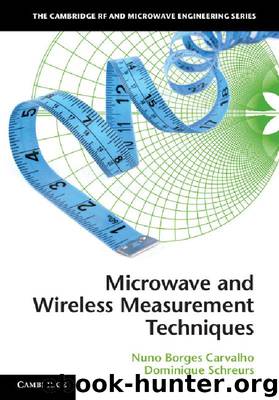Microwave and Wireless Measurement Techniques (The Cambridge RF and Microwave Engineering Series) by Carvalho Nuno Borges & Schreurs Dominique

Author:Carvalho, Nuno Borges & Schreurs, Dominique [Carvalho, Nuno Borges]
Language: eng
Format: epub
Publisher: Cambridge University Press
Published: 2013-09-30T00:00:00+00:00
Figure 2.50 A calibration box. © Agilent.
The sequence in which the standards are connected is not important. Usually, one connects first the three one-port standards (open, short, and load) sequentially to each of the ports, and then the two ports are interconnected with the “through” standard. The standards are not perfect, and therefore the manufacturer supplies their actual reflection coefficient Γ. For example, the “open” standard has a parasitic capacitance value, and the load has a residual inductance value due to the short transmission line connecting the connector to the internal 50-Ω resistor. This reflection coefficient Γ is frequency-dependent.
The standards are applied at the connector ports, and, since this corresponds to the “DUT” reference plane, we can write the following expressions:
(2.35)
(2.36)
(2.37)
(2.38)
(2.39)
(2.40)
The superscript numbers 1 to 6 number the measurements, with O for open, S for short, and L for load.
Next, we can express the DUT quantities in terms of the measured quantities by applying Eq. (2.34). Note that the factor α′1i has been omitted from the expressions, since it will vanish anyhow on taking the ratios for the S-parameters. Thus
(2.41)
(2.42)
(2.43)
(2.44)
(2.45)
(2.46)
with
(2.47)
(2.48)
(2.49)
The above expressions already provide six equations to determine the unknown matrix coefficients. In order to determine all seven unknowns, we also need a seventh measurement, which is the measurement of the “through” standard:
(2.50)
In this expression, it is assumed that the “through” connection is perfect, meaning that the scattered wave at port 2, , is equal to the incident wave at port 1. In reality, the “through” standard will have a delay, or phase shift, and also a small loss. This imperfection is incorporated into the built-in calibration algorithm in the VNA.
As with the other standards’ measurements, we can substitute for the “DUT” quantities the actually measured quantities:
(2.51)
Now we have seven equations, so all of the unknown calibration coefficients can be determined. This concludes the SOLT calibration procedure.
2.6.2.2 TRL calibration
The TRL calibration method was introduced by Engen [11]. The letters of TRL refer again to the standards being used, namely through, reflect, and line. It is an alternative technique to SOLT, especially when the instrument manufacturer’s connectorized calkit or, in the case of on-wafer measurements, calibration substrate is not applicable for the device to be measured. The typical example is measuring devices in test fixtures. SOLT requires an accurately trimmed load. This is a challenge when one has to develop one’s own calibration kit. TRL is less stringent fabricationwise. It does not require a load, the reflect doesn’t have to be accurately known, and the characteristic impedance Z0 of the through and line should be equal, but the value does not have to be known. More precisely, the TRL standards have the following requirements.
• Through. Z0 should be the same as Z0 of the line standard. The attenuation doesn’t have to be known. If it is a non-zero through, the electrical length should be well known and specified if the through is going to be used to set the reference plane.
• Reflect. the magnitude of the reflection coefficient is optimally 1.0, but it is not neccessary to know the exact value.
Download
This site does not store any files on its server. We only index and link to content provided by other sites. Please contact the content providers to delete copyright contents if any and email us, we'll remove relevant links or contents immediately.
| Automotive | Engineering |
| Transportation |
Whiskies Galore by Ian Buxton(41524)
Introduction to Aircraft Design (Cambridge Aerospace Series) by John P. Fielding(32883)
Small Unmanned Fixed-wing Aircraft Design by Andrew J. Keane Andras Sobester James P. Scanlan & András Sóbester & James P. Scanlan(32569)
Craft Beer for the Homebrewer by Michael Agnew(17927)
Turbulence by E. J. Noyes(7690)
The Complete Stick Figure Physics Tutorials by Allen Sarah(7135)
Kaplan MCAT General Chemistry Review by Kaplan(6589)
The Thirst by Nesbo Jo(6432)
Bad Blood by John Carreyrou(6270)
Modelling of Convective Heat and Mass Transfer in Rotating Flows by Igor V. Shevchuk(6219)
Learning SQL by Alan Beaulieu(6029)
Weapons of Math Destruction by Cathy O'Neil(5820)
Man-made Catastrophes and Risk Information Concealment by Dmitry Chernov & Didier Sornette(5641)
Digital Minimalism by Cal Newport;(5384)
Life 3.0: Being Human in the Age of Artificial Intelligence by Tegmark Max(5182)
iGen by Jean M. Twenge(5151)
Secrets of Antigravity Propulsion: Tesla, UFOs, and Classified Aerospace Technology by Ph.D. Paul A. Laviolette(4974)
Design of Trajectory Optimization Approach for Space Maneuver Vehicle Skip Entry Problems by Runqi Chai & Al Savvaris & Antonios Tsourdos & Senchun Chai(4837)
Electronic Devices & Circuits by Jacob Millman & Christos C. Halkias(4739)
